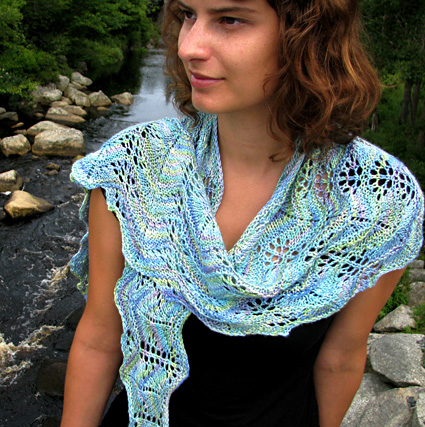

|
|
|

The pale blues of the lustrous handpainted yarn play with the watery theme while spots of yellow, pink, and lavender evoke the colours of wildflowers found along the edges of a stream. This delicate shawlette is worked from the bottom up by building one row of motifs upon the next while increasing the columns of motifs along the sides. The rapid side increases result in a shawl with long tapered ends. These can be draped over the shoulders or even wrapped around to the back and tied to form a shrug. To create a larger shawl, simply continue to increase along
the sides as established until you have the depth you would like.
Decreases at the center in the last repeat help keep the shawlette
in place on the shoulders. |
||

|
Tweet
|
|
|
SIZE |
|
|
FINISHED MEASUREMENTS |
| Length at Top Edge: 57 inches Depth at Center Point: 13 inches |
|
MATERIALS Notions |
|
GAUGE |
16 sts/21.5 rows = 4 inches in pattern stitch (according to the pattern repeat in Chart B), after washing and blocking |
|
PATTERN NOTES |
Sl 1 wyif: Slip 1 stitch purlwise
with yarn in front.
Work from Charts [above] or Written instructions [below], as you prefer. Chart A Chart B |
|
DIRECTIONS Foundation Row [WS]: K3, pm, k to last 3 sts, pm, k3. Begin to work according to Chart A. BO very loosely knitwise, using the larger needle to work the stitches.
|
|
FINISHING I recommend a wet block for this pattern. Gently wash your finished shawlette with a mild detergent in cool water and rinse thoroughly with cool water. Remove the excess water by rolling the shawlette in a towel and gently squeezing the roll. Unroll the towel and spread the damp shawlette out onto a flat surface. The surface will have to be one into which you will be able to place pins, such as a carpet or some other padded surface. Secure with blocking pins. Along each side, pull out the scalloped points that are formed by the stitch pattern and pin into place. Along the long, top edge, pin it in such a way as to emphasize the wavy border. Allow to rest undisturbed until thoroughly dry, usually for at least 24 hours. |
| ABOUT THE DESIGNER |
|
Based in Nova Scotia, Canada, Ilga Leja has been designing classical, elegant knitwear with a contemporary look since 2005. Her designs are often inspired by the natural world around her and she is at her happiest when exploring the banks of brooks and rivers. You can see more of her designs on her website. |
|
Pattern & images © 2012 Ilga Leja . Contact Ilga |